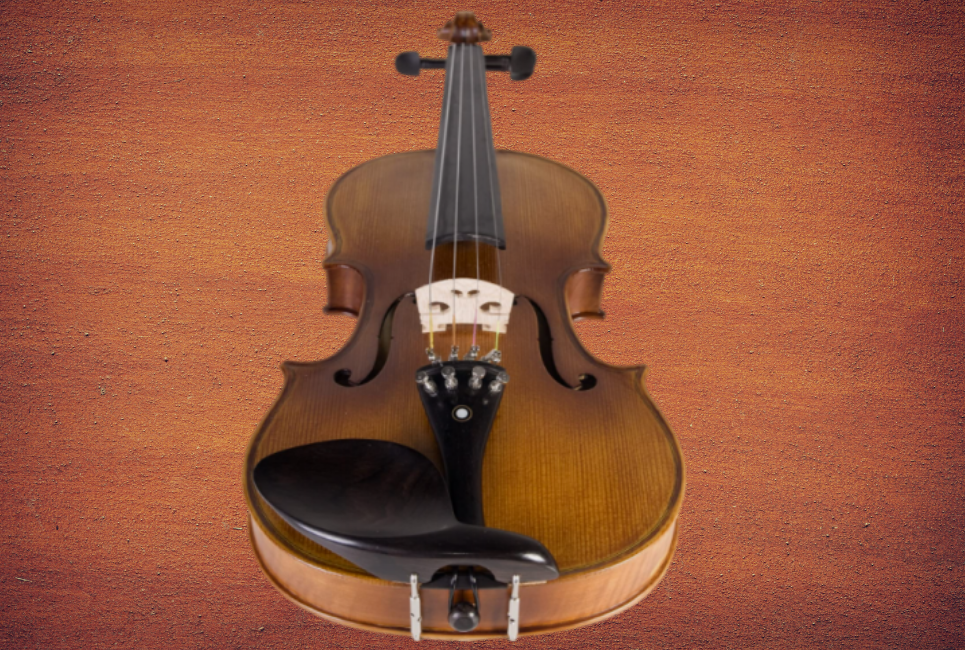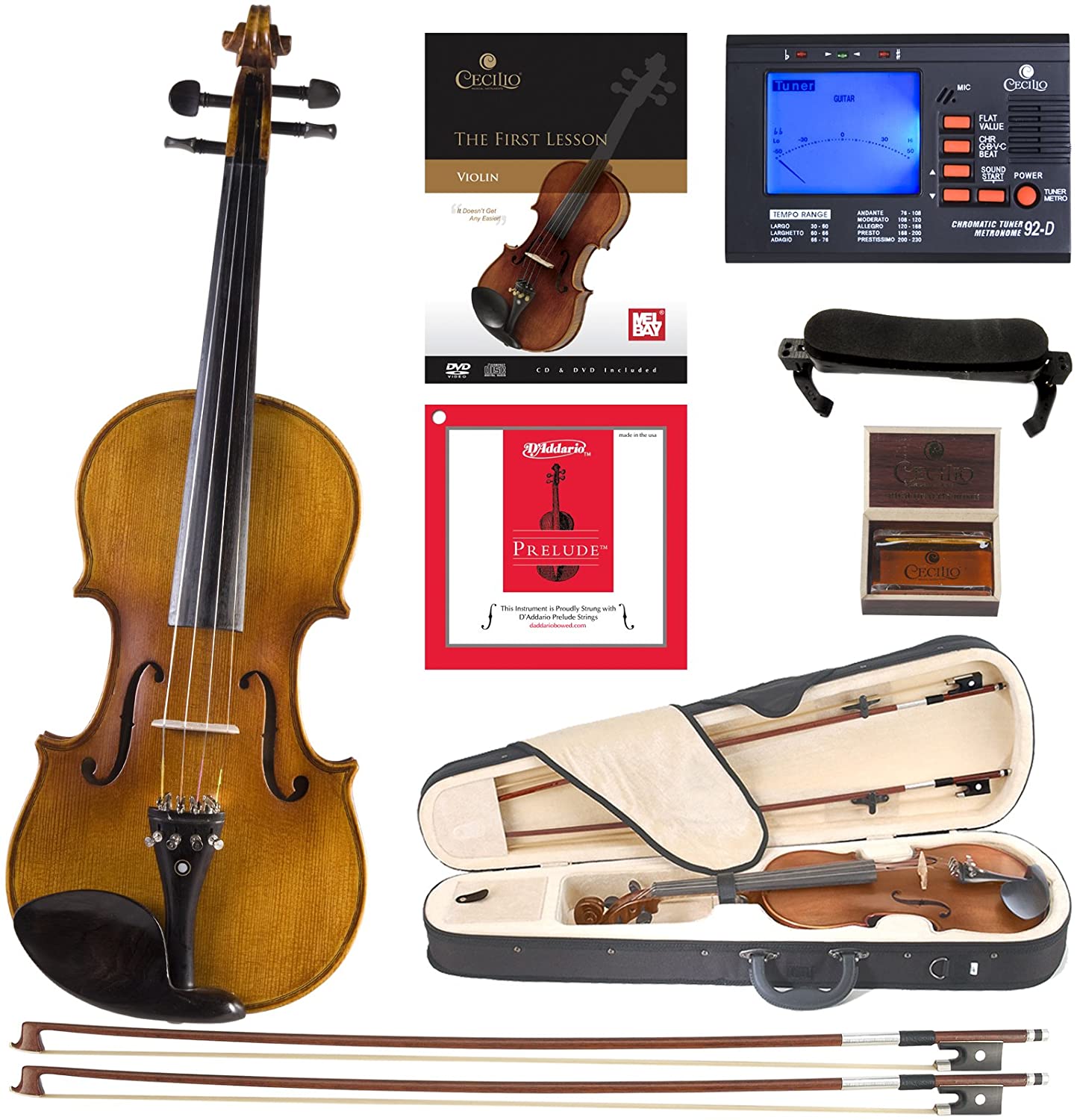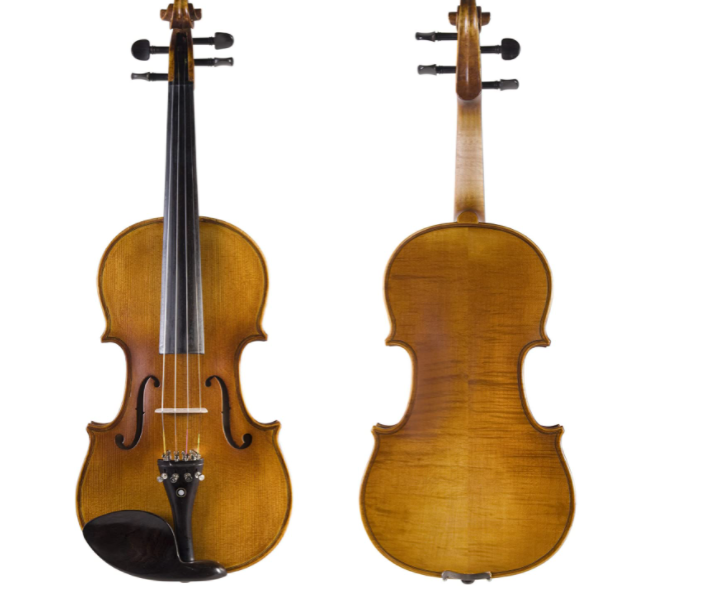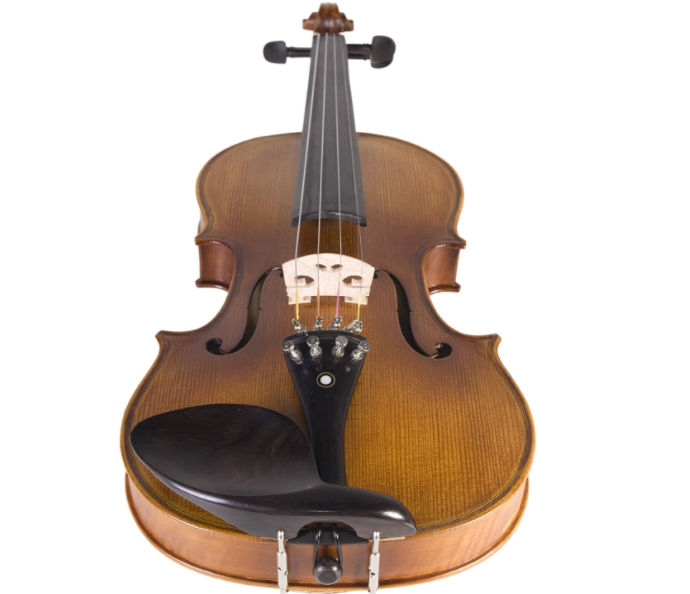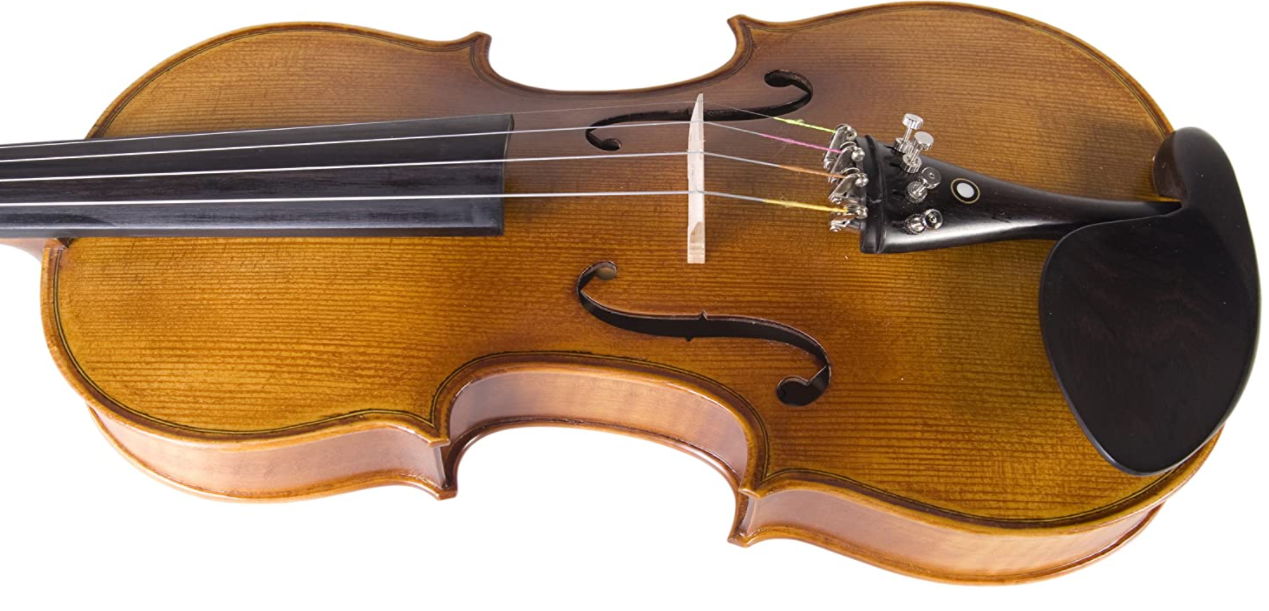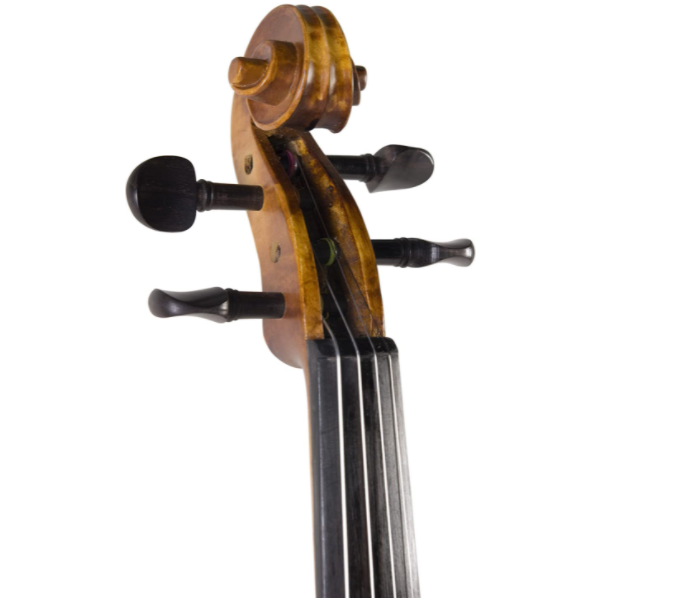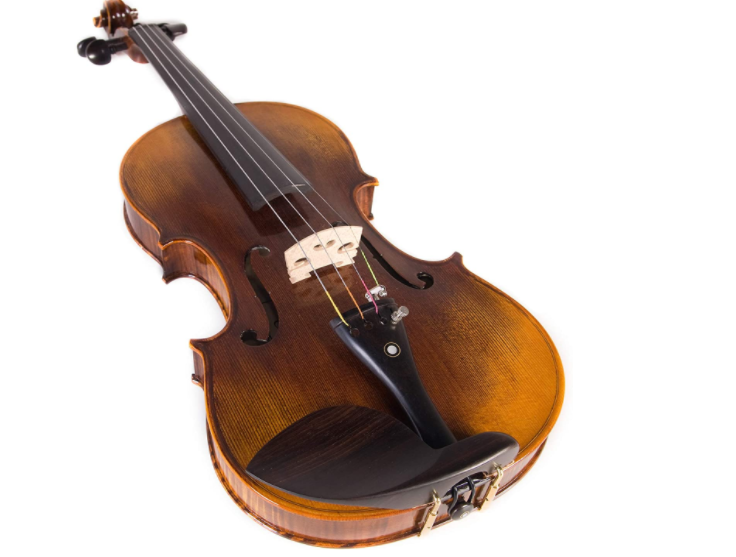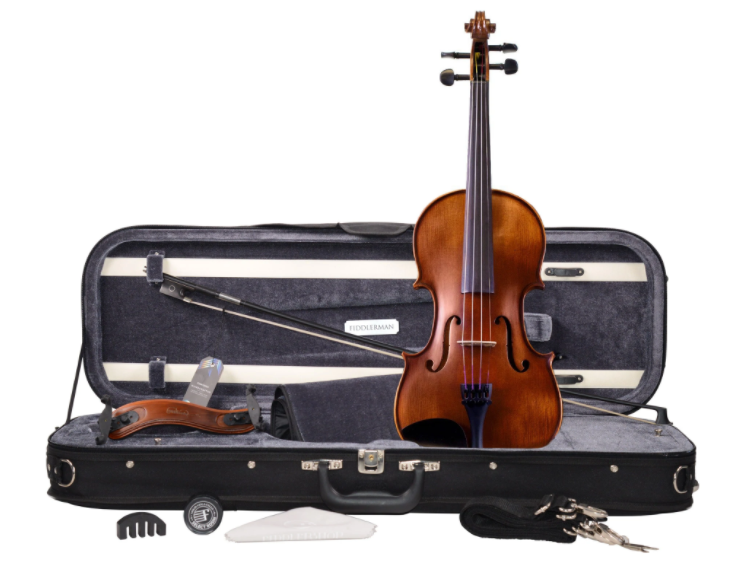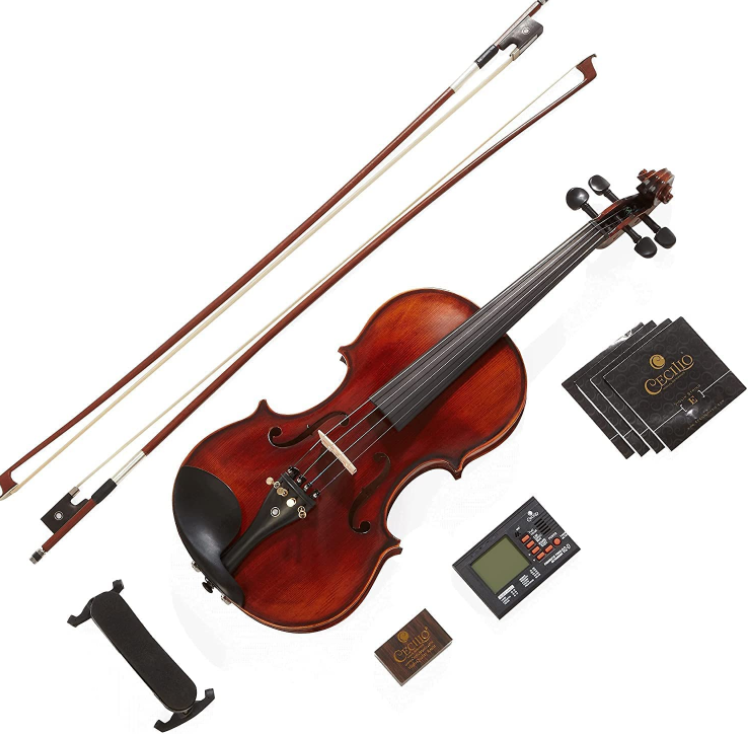- Mendini MV300: An Honest Breakdown and Review - April 6, 2022
- Cecilio Viola Review and Guide: 3 Violas, Which is the Best? - January 21, 2022
- Cecilio Electric Violin Review and Guide: A Silent Practice Violin! - January 20, 2022
Cecilio is a large manufacturer of inexpensive student-quality instruments made in China. While they don’t produce top-of-the-line instruments, they produce basic student-quality instruments that get students started and some that can become faithful companions for years of learning.
The CVN 500 is considered their step-up instrument for advancing students. Still, I put this violin firmly in the serious new student category. It’d be great for someone who has rented for a month or two or borrowed and wants their own violin, especially for the price. The sound is lovely in my opinion, but it may not suit everyone’s taste. Overall it’s a perfect student violin for the price, and I’d highly recommend it.
Pros and Cons Up Front
Pros
- Made with solid flamed tonewoods
- Ebony fingerboard and fittings
- Comes with everything needed to get started
- Cheap!
Cons
- The violin will need new strings right away; I recommend Dominants.
- The bow will need to be replaced right away
- Violin takes a while to warm up
- Will need professionally set up by luthier
Things to Look for When Purchasing a Violin Online
Before we jump into the review, I want to talk about what makes a quality violin and what to look for as you search.
Tonewoods make the violin, and they influence the sound of the violin the most. If your tonewoods aren’t made from quality wood, your violin will not sound like a quality violin. Violins are made from solid carved spruce tops with maple backs and sides because these hardwoods are both durable and carry sound waves nicely. Violins that don’t specify solid carved tonewoods or use other types of wood in the body aren’t quality. You risk getting a violin likely made from pressed wood that will break easily and sound horrible.
Fingerboards are an important part of the violin. They need to be durable and able to withstand oils and dirt from constant skin contact but also flexible so they can be shaped correctly. This is why fingerboards on violins and other orchestral strings instruments are typically made from very durable yet bendy ebony wood. Lower-end student instruments, including some Cecilio and Mendini instruments, use maple fingerboards. This is alright since these instruments aren’t going to last a student more than a year or two but are still not preferred. For less than 50 dollars more, you can get a violin with an ebony fingerboard and a longer lifespan.
The Bridge is an essential aspect of the violin as it helps hold the strings up and vibrate to produce sound; it also helps keep the soundpost intact. More importantly, the bridge needs to be correctly shaped and measured. Professionals’ bridge preferences will vary, and some may even have custom bridges made.
A standard bridge that evenly spaces the strings and raises them to the right height for bowing is important for students. A proper angle will also help students learn not to hit strings. This can only be determined by a luthier and is one of the biggest reasons to take your violin for a full setup.
Fittings include the pegs, tailpiece, chin rest, and endpin. These can be made from hardwoods, and different professional violinists will have different preferences. Student instruments typically come with ebony fittings; very cheap student violins come with dyed hardwood fittings, which can mean anything. I love rosewood fittings but prefer ebony on student instruments for the standardized look, especially as students start to play in ensembles and orchestras.
Tailpieces and fine tuners are part of the fitting package but are very important on student instruments. Student instruments come with four fine tuners, either detachable or built-in. I prefer detachable fine tuners, so students can remove them once they are comfortable tuning the G, D, and A strings with their pegs. Additionally, detachable fine tuners can easily be replaced, whereas built-in fine tuners can’t.
The Finish, otherwise known as the varnish, is another important aspect of a violin. Many student instruments come with a heavy lacquer style finish that weighs the violin down and dulls the tone. Hand-oil rubbed varnish is ideal, but most basic student models just come with a basic varnish in varying colors and finishes. The key is to look for the word varnish in the listing.
Everything Else includes the strings, bow, rosin, shoulder rest, and any other accessories you will find. In terms of strings, I prefer Thomastiks Dominants or Fiddlershop’s strings for student violins. D’Addario Prelude Strings is the student beginning student standard, and I’m happy to see those offered.
I love carbon fiber bows for durability, but most student instruments come with brazilwood bows. The bow needs to be well balanced; always look for reviews that mention the bow. I don’t have a preference for rosin; in fact, I’m currently using some Cecilio rosin I got ages ago.
How Does the CVN 500 Measure Up
The CVN-500 is a great student step-up instrument. In terms of price to longevity, it’s excellent; you or your child/student will receive many years of fun playability from this violin. You will definitely find that this instrument will require some tweaking to get the best sound.
The Tonewoods on this instrument is your basic student-quality solid carved spruce top with a maple back, neck, and sides. The back and sides of this violin are lightly flamed. This just means that the wood grain is growing backward. It’s relatively rare and often seen on expensive professional violins but has been showing up in student and advanced instruments more often. This doesn’t mean anything tonally, but it looks very lovely and adds some personality.
The fingerboard is solid ebony which is perfect for any violin really. There isn’t a mention of how the fingerboard is made, so I’m going to assume it’s machine planed which is fine for the price point. Periodically violin fingerboards need to be replaned as strings create indents in the wood. While this violin isn’t a professional violin, if you play regularly for fun and decide this violin is enough for you, make sure to watch for wear on the fingerboard after a few years of regular playing. During setup, make sure to have your luthier look over the fingerboard as well. I’ve seen the occasional report of wonky fingerboards on their instruments, but that’s usually reserved for the lower-end models.
The bridge is your standard student model from Cecilio and typically comes uninstalled to keep it from damaging the instrument. I highly recommend getting the bridge checked out by a luthier during setup. They can make sure it’s been spaced and measured correctly. They’ll also be able to make notches in it if it comes unnotched and add other adjustments that will help you get the most out of your violin. If needed, they can replace the bridge completely.
The Fittings are pure ebony, which is great for both durability and the overall look of the violin. I recommend having your luthier also look at the pegs of the violin as well. They’ve been reported to be very smooth and easy to tune, but it’s always great to get a second look at an instrument that is this cheap.
The tailpiece is made from pure ebony and contains four detachable fine tuners. This is ideal for an instrument like this. While this probably won’t be the last violin you ever play, it will take you well into the intermediate area of playing. Once you advance past the basics of playing, you will become comfortable tuning your violin purely with the pegs. You won’t rely on the fine tuners anymore. At this point, many students either trade up their violin or take off the fine tuners if they have detachable ones and are happy with their current instrument. I got a new violin, but it felt like a badge of honor to only have one fine tuner on my E string, like advancing students. However, I’ll admit I prefer just how precise I can tune with a fine tuner.
The Finish on this violin is satin antique. There is no mention of how it is applied, but it’s very light and has a matte finish. Overall the look is very bright and rather yellow. It’s not my personal taste, but the violin is beautiful nonetheless, and it’s definitely not a shiny lacquer.
Everything else included with this violin is of decent quality, except the bows. I particularly like that it at least comes with proper D’Addario Prelude strings over their in-house brand. However, this violin would fair much better with at least some upgraded Thomastiks Dominants, Fiddlershops Strings, or even D’Addardio’s Pro Arte’s or Helicore strings. This will give the violin some extra oomph in the tone department, which we will discuss below.
The bows can be thrown in the trash; I honestly hate them and would recommend ordering something better off the bat. They are notorious for coming warped and unbalanced. I’d recommend a carbon fiber bow from Fiddlershop, Cadenza, or Coda. I have 3 Fiddlershop carbon fiber bows (I know I have a problem) and one Glasser bow, along with a few brazilwood bows.
The Fiddlershop is clearly my favorite, and at the price point, it’s easier to re-buy bows over re-hairing them. They are durable and well-balanced; they don’t easily bounce off the strings. Most importantly, I find staccato and accented notes easy to play. The Cadenza bow is probably the best one I have; it’s certainly the most expensive.
However, I find it comparable to the Fiddlershop bow for the price. The Coda bows are the most expensive but are well worth it if you want to spend the money. You’ll keep this bow with you for a while due to its quality; it’s definitely worth re-hairing several times for years of use.
The case is a basic triangle-shaped suspension Cecilio case. It’s pretty basic with a small pocket for rosin and enough space in the neck area to put your shoulder rest. There are two bow holders as well. It does the job, but an upgrade in a year wouldn’t hurt at all. A suspension case with more storage space and a hydrometer and/or humidifier would make a great present for the advancing musician.
The rosin is your basic Cecilio standard rosin, the same with the shoulder rest. They get the job done and don’t need to be replaced unless they break. The rest of the outfit includes a tuner and a lesson book to get started—overall a great value for the price.
So What Does the CVN 500 Sound Like
To hear the CVN 500 for yourself, check out this review by Allison Sparrow, the Online Piano and Violin Tutor; I also recommend checking out the comments for some thoughts from violinists who have had this violin long enough to really warm it up to its true sound.
Overall I like the sound of this violin. It’s much deeper and darker than any other violins I’ve heard. The E string isn’t nearly as bright as I’ve heard on my own violins, which is pleasant to me but probably won’t suit every player. The G string is nice and clear but doesn’t have any growl or oompf. Basically, it’s the perfect advancing student violin, as it will blend in well for ensemble performances in orchestras or smaller groups.
It’s also pleasant to listen to as you practice neither too shrill nor too deep. Experimenting with strings will help you get the sound you want from this violin. I’d start with Fiddlershop or Dominant strings as they are what I consider the baseline for upgraded strings and adjust from there.
Other Violins to Check Out
Cecilio’s CVN 600
Cecilio’s CVN 600 is the highest quality violin that they sell. Its made from solid aged tonewoods and features a one-piece highly flamed maple back. The fingerboard and fittings are made from ebony, and the tailpiece features 4 detachable fine tuners. It comes strung with D’Addario Prelude strings and all of the other accessories you will find in the CVN 500.
It’s both a big step up in price and quality but will remain a faithful musical companion for years to come. It’s a beautiful instrument with a very bright and clear upper register and an even lower register. I personally prefer the look and feel of the CVN 600, but I love the sound of the 500.
Fiddlershop’s Apprentice Violin
Fiddlershop’s Apprentice Violinis a big step up in price, quality, and tone. Fiddlershop’s instruments are made in China, similar to Cecilio’s violins. Still, these violins are created under the direction of Fiddlershop’s owners Pierre and Michael Holstein, who are professional musicians. Pierre has over 40 years of experience as a professional musician.
His aim in creating Fiddlershop was to offer an online string store that provides quality instruments and accessories at an affordable price for beginners and professionals alike. The Apprentice Violin features aged solid carved slightly flamed spruce and maple tonewoods with 100% ebony fingerboard and fittings.
The tailpiece is made out of carbon, a durable material, and features 4 fine tuners. The bridge is either a hand-carved French Despiau or Holstein 1-star, and it’s strung with Fiddlershop strings. It arrives completely set up and ready to go. The outfit includes a Fiddlerman Carbon Fiber bow, shoulder rest, dark rosin, practice mute, and digital tuner.
Mendini MV500/650
Mendini MV500/650 is Cecilio’s child company Mendini’s CVN 500. This violin is a mix between the CVN 500 and the CVN 600, which makes it one of the most interesting violins in either line-up. It features a hand-carved solid spruce top with a 1 piece maple back and sides similar to the CVN 600. With all ebony fittings and a tailpiece with 4 fine tuners, this violin is set up great for a student. The finish is a satin varnish that is darker than the CVN 500 but comes with a satin matte finish that is, in my opinion, absolutely gorgeous.
The sound is much closer to that of the CVN 500 with a clear lower register and mellow higher register but a tad brighter than the CVN 500. Changing out the strings would produce a more even and better quality tone, along with a setup by a luthier. The outfit comes with everything you get in the CVN 500. This is a great serious beginner violin and honestly is a great alternative to the CVN 500 if the look isn’t your style.
FAQ
Answer: This is tough because each brand and instrument has its own pros and cons. Overall I’d recommend Cecilio because their outfits come with better strings. However, purchasing new strings doesn’t add much when you already have to get the instrument set up. If you like the look of a Mendini violin more, I recommend you get that one.
Each line is nearly identical to the Cecilio counterpart, so they can typically be switched out without a ton of difference. I prefer the MV 500 over the CVN 500 purely due to aesthetic reasons, as I’m not a fan of the yellow finish on the CVN 500. I also prefer the look of a one-piece back over a two-piece back.
Check out our Cecilio and Mendini buying guides!
Answer: This is dependent on how much you play and your skill level. Professionals change their strings as often as every 2 months. Students can typically get almost a year out of a good set of strings. If you practice more than an hour a day or play in ensembles or orchestras in addition to lessons, I’d recommend changing every six months.
Watch a tutorial on changing strings here!
Answer: Similarly to string, this will be dependent on how often you practice and what your musical career looks like. Most students can get a good year out of a bow, but the more you play, the more often you will need to re-hair or replace. Advanced students who play in ensembles or do performances will find they need to re-hair every six months.
Final Thoughts
The CVN 500 is a beautifully sounding student violin that will be a musical companion for years. It features everything I look for in a student violin while producing a beautiful sound that will allow students the versatility of advancing their skills and new opportunities in their musical careers. Complete with everything you need to get started, you won’t be disappointed with this violin, but you may want to tweak a few things!
Looking for more interesting readings? Check out:

